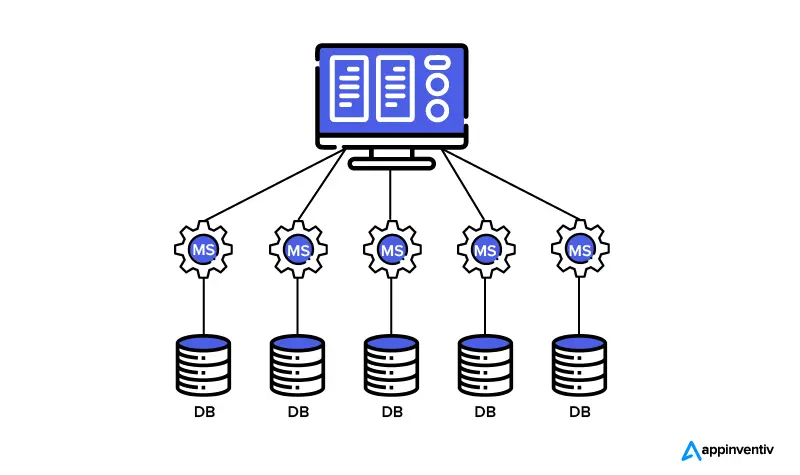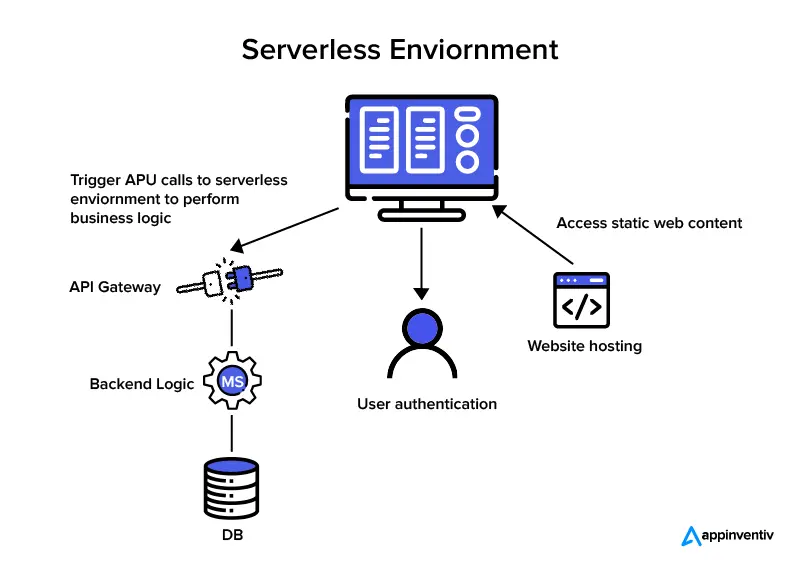- What is a Microservice?
- What is a Serverless Architecture?
- Roles and Resources Required for Serverless vs Microservices
- Combining Serverless and Microservices
- Real-World Examples
- Microservices architecture real-world examples
- Serverless architecture real-world examples
- How can Appinventiv help in making the right decisions for Serverless vs Microservices?
- Key Takeaways
- FAQs
For every business, the use of technology is one of the primary aspects that differentiate the organization from its competitors. Thus, it becomes imperative for organizations to upgrade based on the new technologies.
Having said that, it is equally important to ensure that the organization finds the balance between future technology flexibility and return on their current technology investments. Thorough preparation and knowledge of the integrities involved in the process of up-gradation should be weighed while taking this into consideration.
Technology has been advancing at a rapid pace, and so is the need for applications that can scale easily and are agile enough to perform better with continuous delivery. Such evolving requirements have given rise to technologies like microservices and serverless computing.
Two architectures are mentioned here that raise an inquisitive question – Which architecture will suit our business needs, serverless vs microservices. Sometimes one is more suited than the other. While both technologies adopt different approaches, security remains the priority for both architectures.
To understand the difference between the two, it is important to understand what is serverless architecture and what is microservice architecture.
What is a Microservice?

Microservice is the architectural pattern of breaking down the application into smaller applications or services, thus the name. This is the exact opposite of monolithic architecture where a single entity contains all the functionality.
For better understanding, let us take an example of an eCommerce application. The user searches for the product/s, add them to the cart, and places the order. There are multiple services that are working independently and are brought together through Application Programming Interface (API). Services like a product, cart, and checkout through a payment gateway are microservices.
There are multiple ways in which microservices can be implemented. For it to run independently, each microservice contains the basic elements – its own database, libraries, and templates. It basically follows the rules of SOA (Service Oriented Architecture) where the user gets the leverage of creating new applications and can run various applications independently.
The DevOps breaks down all the application’s functionalities into smaller applications/services that work independently while retaining the functionality of the application. These microservice applications are developed and tested individually for their functionality before deploying.
Such an architectural framework is advantageous because even if one microservice gets corrupted or undergoes maintenance, it is easier to fix it without affecting the other services and subsequently the overall functionality.
Types of Microservices
- Stateless Microservices
This type of microservice does not store the existing data. At the time of every use, a new interface is created and the data need to be added every time as the data is never preserved.
- Stateful Microservices
This type of microservice always maintains a record in the database that makes it easier for the user to code efficiently. Such information should be stored externally in the data store like RDBMS, noSQL database, etc.
[Also Read: Microservices vs Monolithic Architecture: Which is Right for Startups?]
What is a Serverless Architecture?

The serverless architecture is where the application is partly or completely hosted on a third-party server like cloud computing. The term, though, is misleading that there is no server. Instead, it means that the organizations do not have to worry about spending in or maintaining the physical hardware at their location. Physical infrastructure, network, storage, etc., is managed by a trusted third party.
In a nutshell, developers just need to focus on coding. Everything else is taken care of by the service provider from security patches to load balancing, capacity management, scaling, logging, and monitoring. Some of the popular third-party platforms include AWS Lamba serverless architecture, Microsoft Azure architecture, and Google Cloud.
Serverless architecture works on two different perspectives –
- Function as Service (FaaS)
This service enables the user to create a modular architecture that will be scalable and efficient with the use of a handful of resources. The best example of FaaS is Cloudflare Workers.
- Backend as Service (BaaS)
This service is basically used to create applications for mobiles and the web. The use of third-party services enables the users to focus on the front end of the application. The best example of BaaS is AWS Lambda.
For ease of understanding, refer to the table below to know what is serverless infrastructure and what is a microservice infrastructure.
| MICROSERVICES | SERVERLESS |
|---|---|
| Small independently functional applications are developed | Offers an environment to execute the code anyway anywhere |
| This is SOA (Service Oriented Architecture) | This is a cloud computing model |
| Microservice has the technology within a cloud-based environment | Serverless functions are the only way to host microservices |
| It is a technique to create an application | You can run the applications on Serverless architecture |
| Mature architecture | Less matured |
| Multiple solutions can be managed | Difficult to monitor and manage logs |
The primary difference is – microservices is a technique to design an application, whereas serverless is the architecture to run the part or complete application. Microservices can be hosted on serverless architecture.
Ideally, one should opt for serverless functions when the organization needs automatic scaling and lower runtime costs, and microservices architecture should be opted for by the organization when looking for flexibility and want to shift to modern architecture.
Roles and Resources Required for Serverless vs Microservices
As mentioned above, microservices are smaller applications developed that integrate to form a bigger application while working individually. To create an application with this architecture, the planning stage should be thorough to know what all microservices need to be created and how will they interact with each other through APIs. An experienced software architect can manage this role efficiently.
To develop the applications, you need to have a team of developers and testers who have a clear understanding of microservices architecture. Microservices are not language-specific and can be created in any software language. Having said that, the most often used technologies are JS/TypeScript, Java, .NET, and Python. Small, cross-functional teams of developers work better together.
It is noticed that the cost of microservices is higher during the development process but is cheaper in the long run. The maintenance costs too are less as the application continues to function normally even if one of the microservices is down. Smaller applications not only take lesser time to remove the bugs but is easier and cheaper to maintain.
To implement the serverless application architecture, you need to find a good service provider like AWS Lambda, Microsoft Azure Functions, Google Cloud Functions, and Cloudflare Workers. Also, you need to choose between FaaS and BaaS to write all the functions and their triggers.
The development team needs to have a strong background in working with the service provider of your choice. The developer should be thoroughly adept with JavaScript or Python skills.
It is comparatively cheaper to host an application or its part on a distant server, thus the cost of development is also less. Also, the application can be launched in no time.
Combining Serverless and Microservices
The organization can choose between serverless vs microservices based on their needs as mentioned above. However, the development team can actually develop microservices as a set of event-driven functions that can be stored on third-party’s infrastructure.
By following the below-mentioned approach, the development team can bridge the gap and combine microservices architecture vs serverless architecture.
- For a microservice to be serverless, it should be event-triggered. Microservices should respond to particular conditions and user actions for them to work as a function.
- With the use of Logic Apps (Microsoft) or Step Functions ( Amazon), triggers can be assigned to microservices and several functions can be combined into a service. This increases the feasibility of integrating them together.
- Serverless function development is highly dependent on cloud storage and computing. Thus, it is important to move to cloud infrastructure such that you can implement certain principles from serverless architecture.
Real-World Examples
Based on the above differences and architectural approaches, let us now explore some of the real-world examples of both the architectures that might further help you in choosing the right architecture for your business.
Microservices architecture real-world examples

1. Netflix – Netflix is one of the first organizations to adopt microservices cloud computing or serverless microservices that are used for server maintenance, reliability, and algorithms for recommendations of the shows.
2. Amazon – With exponential growth, multiple services were introduced. However, initially, the company was following the monolithic architecture that was expensive. The company then rebuilt the application into microservices.
3. Uber – All the business processes are managed through microservices architecture such as passenger management, billing, notifications, and many more.
Serverless architecture real-world examples

1. Nordstorm – The shopping website built its own framework based on serverless architecture. Their website used serverless to build an event-based application and add more features.
2. Codepen – It is a social development platform for frontend developers and designers to help build a website that is run by a one-man DevOps team as serverless does the rest.
3. Figma – With the help of serverless architecture, users can collaborate on one design while developers can focus on their projects rather than file management.
How can Appinventiv help in making the right decisions for Serverless vs Microservices?
With our expertise in digital transformation services, We, at Appinventiv, strive for excellence in every project we take up, irrespective of size. We have been helping organizations meet their business goals within the stipulated timelines and costs.
For instance, we have successfully built a customer-centric data analytics platform for one of the largest US-based telecom companies. By leveraging Business Intelligence, we could ensure 100% data availability to every department of the company in real-time.
With our best-in-class cloud computing services, we can help you choose the right architecture that would be beneficial for your product or get both aligned with the most efficient integration solution best suited to your business needs.
Talk to our experts to learn how can we partner with you to help you achieve your business goals.
Key Takeaways
Serverless vs Microservices, both the technologies are structurally similar following different approaches. As against monolithic architecture, both serverless and microservices prioritize scalability, flexibility, cost-effectiveness, and ease of adding new features. The focus of microservices is long-term scalability as each service works as an application in itself.
One can choose between the two approaches based on the company’s product scope and priorities. If you are planning to build a large platform that requires constant scaling, microservices will provide you with serverless microservices for long-term solutions. If you are looking for a cost-effective and quick launch, serverless architecture is a good choice.
FAQs
Q. Can serverless and microservices work together?
A. It is not necessary to choose either one of the architectures. Some applications deliver the best when the two architectures are brought together. Microservices and serverless integrate and complement each other with their specific strengths and weaknesses. Microservices can be deployed as a part of serverless application architecture.
Q. When is it that you should not use microservices architecture?
A. One must not use microservices architecture when:
- The defined domain is unclear or uncertain
- Improved efficiency is not guaranteed
- The application size is too small
Q. When is it that you should use microservices architecture?
A. Microservices are useful when big applications need to be developed that can afford the upfront costs. Applications that are small and lightweight can be maintained as monolithic architecture.
- Applications that need to scale up or down
- Adding new functions is a regular requirement
- In big data applications
- Rewriting legacy applications
- Need to reuse some of the components from more than one software



How Much Does it Cost to Build a Cloud Based Digital Signage Software?
Imagine you are an entrepreneur with a vision: a world where digital displays are everywhere, delivering timely information, immersive advertising, and dynamic content in places as diverse as airports, retail stores, and corporate offices. You have also identified the growing demand for digital signage—something seen in its $26.5 billion market size—but creating robust cloud-based enterprise…

Cloud Manufacturing Software - Benefits, Types, Development Process and Cost Analysis
Cloud computing is set to become a bigger part of the manufacturing industry's future as it continues to embrace digital transformation. With advancements in manufacturing software, cloud-based solutions are here to stay and only grow with time. The potential of ERP can be realized with the help of cloud manufacturing software, which eliminates the need…

Cloud Computing in Oil and Gas Industry - Identifying Business Opportunities and Challenges
In an industry where the pressure of data is as intense as the pressure in the deep sea, oil and gas companies grapple with managing enormous volumes of information, streamlining operations, and controlling costs. Traditional systems often buckle under the weight of this data deluge, leading to fragmented processes, operational inefficiencies, and hefty capital expenditures…










